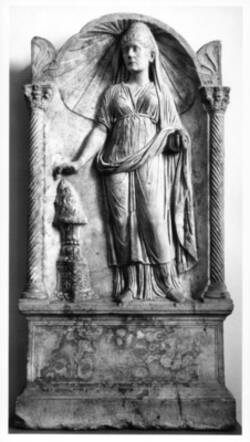Above a massive plinth zone with a transverse rectangular inscription field stands a woman with her hand outstretched. The architecture surrounding her - two twisted columns and a shell-shaped pediment - is reminiscent of a small temple in which she is offering incense: From the round container (acerra) she has taken the resinous grains of incense and is scattering them into the flames of the turibulum standing to her right. This incense stand consists here of a three-sided base, the shaft and the sacrificial bowl. The middle-aged woman wears plaited plaits twisted into a turban over her slightly wavy hair - a fashionable hairstyle of the time, as also worn by the Empress Faustina the Elder (105-140 AD). Although she has piously wrapped her cloak around her lower body and pulled it over the back of her head, the high-belted and body-hugging chiton emphasises her feminine forms. Who the sitter is remains uncertain, but since another portrait of her has survived, it is probably a member of the Roman upper class.
The enormous dimensions of the monumental funerary altar, which may have originally been four times as wide and of which only the front has survived, also speak for a well-off client.
Further Media
- Location & Dating
- Mittleres Drittel des 2. Jhs. n. Chr. Dieselbe, namentlich nicht bekannte Person ist auch in einem rundplastischen Porträt dargestellt, das sich im Museum von Tarragona befindet.
- Material & Technique
- Weißer, großkristalliner Marmor
- Dimenions
- H: 221,0 cm, B: 112,0 cm, T: 34,0 cm
- Museum
- Skulpturensammlung
- Inventory number
- Hm 359
